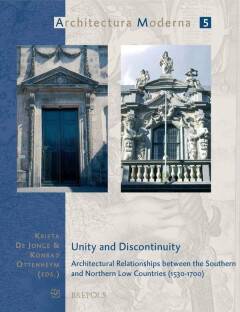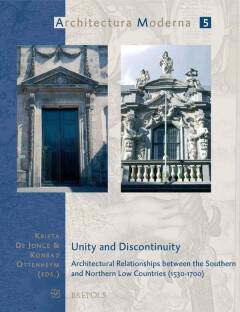
Je cadeautjes zeker op tijd in huis hebben voor de feestdagen? Kom langs in onze winkels en vind het perfecte geschenk!
- Afhalen na 1 uur in een winkel met voorraad
- Gratis thuislevering in België vanaf € 30
- Ruim aanbod met 7 miljoen producten
Je cadeautjes zeker op tijd in huis hebben voor de feestdagen? Kom langs in onze winkels en vind het perfecte geschenk!
- Afhalen na 1 uur in een winkel met voorraad
- Gratis thuislevering in België vanaf € 30
- Ruim aanbod met 7 miljoen producten
Zoeken
Unity and Discontinuity
Architectural Relationships Between the Southern and Northern Low Countries (1530-1700)
Krista De Jonge
Paperback | Engels
€ 58,30
+ 116 punten
Omschrijving
This study focuses on change and continuity within the architecture of the Southern and Northern Low Countries from 1530 to 1700. Instead of looking at both regions separately and stressing the stylistic differences between the classicist North and the baroque South, the book establishes a new, common history of architecture for both parts of the Low Countries during the 17th century. Their reception of Antiquity in the guise of the Italian Renaissance, first introduced in Court circles in the early 16th century, constituted the common heritage on which they built after the political separation. The book also reassesses the position of Netherlandish architecture in the international debate on the Renaissance north of the Alps. Krista De Jonge is professor of architectural history at the Katholieke Universiteit Leuven. She has published extensively on early modern Netherlandish architecture, including Burgundian and Habsburg court residences and the Renaissance problematic. Konrad A. Ottenheym is professor for architectural history at Utrecht University. His research is focussed on Dutch early modern architecture and its international connections.
Specificaties
Betrokkenen
- Auteur(s):
- Uitgeverij:
Inhoud
- Aantal bladzijden:
- 428
- Taal:
- Engels
Eigenschappen
- Productcode (EAN):
- 9782503513669
- Verschijningsdatum:
- 8/05/2007
- Uitvoering:
- Paperback
- Formaat:
- Trade paperback (VS)
- Afmetingen:
- 222 mm x 276 mm
- Gewicht:
- 1995 g

Alleen bij Standaard Boekhandel
+ 116 punten op je klantenkaart van Standaard Boekhandel
Beoordelingen
We publiceren alleen reviews die voldoen aan de voorwaarden voor reviews. Bekijk onze voorwaarden voor reviews.









